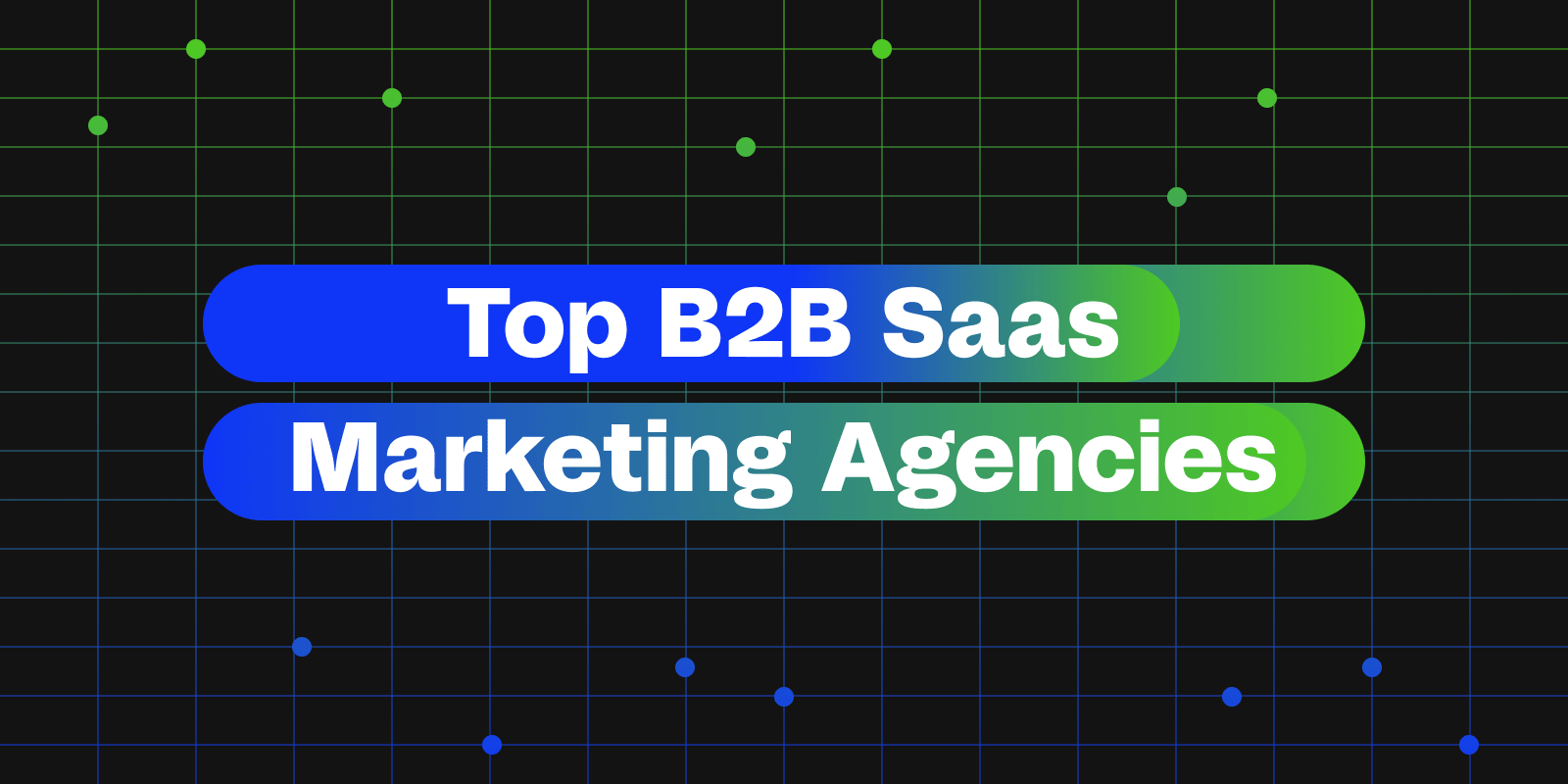When Klarna was founded in 2005, it entered an arena saturated with companies and brands speaking to the reason of their customers, offering logical solutions on how to save money, and focusing on the transactional aspect of shopping. In this sea of brands, Klarna’s marketing strategy developed in a different direction. In addition to a superior checkout experience, the Swedish bank started speaking to the emotional nature of its customers. It offered an end-to-end inspirational and “smoooth” shopping journey, which became the key driver of Klarna’s exponential growth.
Want to learn more about how leading FinTech companies are driving growth? See how we drove an 82% increase in leads for Citi Banking.
What Is Klarna?
Klarna is a unicorn financial technology company, also a bank, with its roots in Sweden that has been transforming how consumers shop and pay for products online. The Swedish company offers a payment service that allows online shoppers to make purchases from major retailers without necessarily completing the full payment at checkout. Instead, shoppers can divide their payments for their purchases in four interest-fee installments automatically charged every two weeks, or choose to pay the full amount within 30 days. They also have the option to also take advantage of Klarna’s credit options to finance larger purchases over six to 36 months.
Early Years: Speaking to the Rider
Founded in Stockholm in 2005, Klarna was on a mission to make online shopping as easy as possible. Since then, Klarna has become one of Europe’s largest banks with 90,000,000 customers, over 200,000 merchants, and at least 1,000,000 transactions a day.
Before it became the fintech unicorn with an edgy identity and a promise of a “smoooth” shopping experience, Klarna entered the Swedish market with a simple and logical pitch — “Buy now, pay later” and “Buy safely online.” Just like many other players in the field, from PayPal to Afterpay to commercial banks, Klarna speaks to the customers’ inner Rider, appealing to their reason by offering secure and easy ways to shop and save. Early-stage Klarna’s blue, trust-inspiring color is different from today’s eye-catching, playful, and young pink color palette the company has adopted.
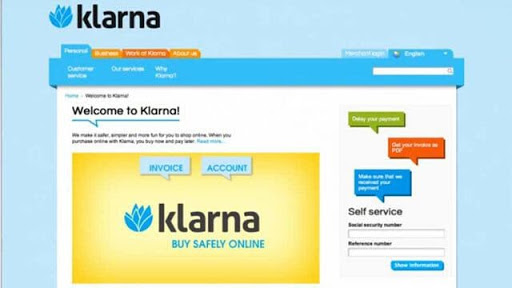
As the company expanded in Europe, entering competitive markets from Austria to the UK, it reached more than $2 billion in valuation by 2015, officially claiming the title of a unicorn. That year, the company officially launched in the US and prepared to take the payment industry in the United States by storm. By 2016, Klarna had successfully been ranked 8th on CNBC’s 2016 Disruptor 50 list, surpassing such iconic startups as Snapchat, Slack, and Spotify.
The Rise of the “Smoooth”
The period between 2016-2017 was that exact turning point that made Klarna the wild success story it is today.
The transformation began with the launch of the proprietary concept of “Smoooth” shopping — spelled exactly like that, with three “o’s.” The bank began the process of shedding the older layers of seriousness so typical to the financial industry; it began taking solid steps away from the traditional, reason-driven marketing and growth pattern so many competitors in the field complied to — and with it, kicked off the disruption of the payment industry immediately.
The campaign that crystallized the “smoooth” idea involved a series of odd, quirky, whimsical videos infused with color and animation. The execution of the campaign videos was so realistic, that the unicorn was contacted by animal rights criticizing the company for a video featuring an animated wish on a slide.
Smoooth, indeed.

Klarna also took its final step in completely abandoning the cold and serious (or as they call it, boring) blue hues and instead embraced the bold imagery and the pink color the brand is recognized for today.
Once the “smoooth” term, along with the appearance and identity of the brand, was coined, Klarna added a new touchpoint for customers to interact with the brand — the Klarna application. This launch was significant for a few reasons.
First, it took the concept of “smoooth” purchasing yet another step further, taking over the end-to-end shopping experience and expanding beyond an easy and simple checkout process. With the app, Klarna now promised inspiration, product browsing, and exploration that would lead to complete purchases. Essentially, Klarna ensured consistency in “smooothness” of the entire shopping process including inspiration and motivation to buy, easy payment, and a seamless post-purchase process.
As another key touchpoint for interaction with customers, Klarna created another opportunity to maintain consistency in tone, identity, and mission that would apply the concept of “smoooth” shopping beyond the product itself and to the strong connections the brand was building with its customer base.
“Every aspect of what we do oozes smoooth,” the Klarna website says. “Smoooth payment experience, smoooth technical solutions, smoooth office, smoo… OK, you get the point.”
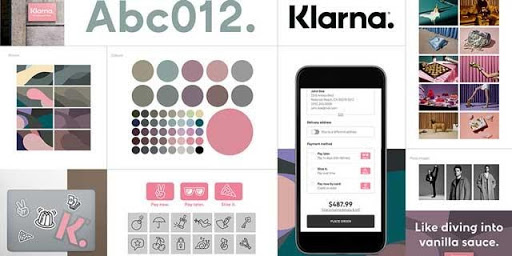
And then came 2019 — and with it, the most daring campaign that set Klarna apart from all other players in the rigid fintech industry, for good.
Klarna kicked the year off with their biggest marketing campaign to date, “Get Smoooth,” featuring Snoop Dogg as spokesperson and investor. As an homage to the campaign, Snoop Dogg even changed his name to “Smoooth Dogg” temporarily. Klarna’s Chief Marketing Officer, David Sandström, told Campaign Live in an interview: “We asked: ‘Can one of the smoothest people in the world be even smoother by using our product?’ Banks are seen as stiff and we’re trying to change that with Snoop Dogg.”
The campaign became an immediate success with extensive press and social media coverage worldwide — and crystallized Klarna’s status as an emotion- and creativity-driven industry disruptor.
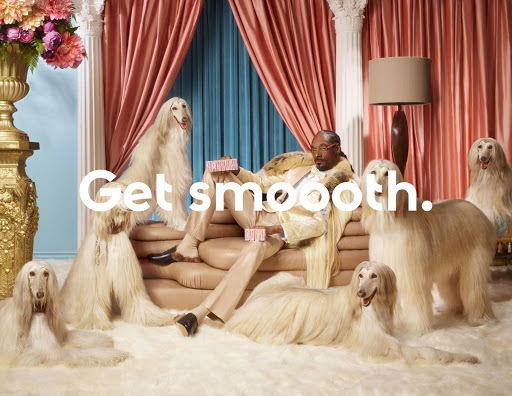
Klarna Today: a Creative Disruptor
Klarna’s fresh marketing and branding strategy was a pivotal point in its efforts to gain market share and establish a strong foothold in an otherwise saturated marketplace, creating a brand that consumers have come to connect with. Across all the possible touchpoints where customers interact with the company, Klarna makes sure it puts its reinvented brand at the forefront at all times, developing emotional bonds with shoppers and stepping outside of the traditional logic-driven and “serious” marketing strategy so typical of the fintech industry.
Klarna is, no doubt, disruptive in every way possible. From a superior product offering to a growth strategy driven by strategic partnerships, customer-centricity, and an agile internal organization, the brand has taken the fintech industry by storm and continues to push the boundaries of the payment industry “normal.”
Customer Centricity
The role of the customer is also indispensable in Klarna’s strategic growth and expansion. At the root of every strategic decision Klarna makes is in the best interest of the shopper — and this connection the brand has built is deeply emotional and personal.
Klarna goes the extra mile to create experiences uniquely tailored to the preferences and personalities of its users.
The brand hosted a pop-up experience in October 2019, “House of Klarna”. The pop-up consisted of a series of talks by C-suite executives, beauty and lifestyle sessions, and even yoga. The 10-day experience wasn’t simply a strategy to gain more publicity; Klarna designed an out-of-the-box, premium customer experience for its current and potential shoppers to interact with the brand and develop a liking towards it. On the brand’s behalf, this was a push to truly engage the shoppers’ internal Elephants — something unprecedented in the payment and fintech industries.
Around the same time, Klarna also tapped into the world of dog owners and dog lovers through its first-ever pop-up — or rather, pup-up — grooming salon for a quirky, whimsical grooming experience. The campaign, ironically called “Who Is a Great Shopper,” didn’t just provide grooming services; it was an opportunity for dog owners and aficionados to shop for the ones they loved the most — their best animal friends. Klarna put the shoppers and their furry friends at the heart of the campaign, celebrating their love relationship while essentially nurturing a relationship of its own — namely, one between Klarna’s brand and its shoppers.
In October 2020, Klarna hosted an immersive gaming experience, Playing for Keeps, to announce the new partnership with GameStop and engage the global gaming community in an online interactive event. The community was given the chance to play against two professional gamers, SypherPK and KittyPlays. All of the items in the gaming experience, from consoles to gaming chairs and even apparel, were winnable and taken away from the live stream in real-time, one by one, after each player’s victory. The event also featured celebrity guest appearances by Snoop Dogg and Lil Yachty.
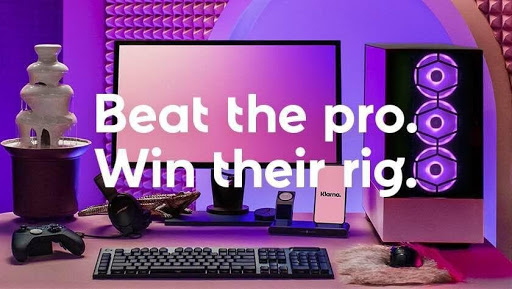
Strategic Partnerships
Klarna’s list of partners has been growing exponentially and already involves over 200,000 merchants worldwide. Major names like Zara, Nike, ASOS, Missguided, and Sephora chose Klarna for its customer-centric and extraordinary approach to engage users and scale.
Klarna’s genius lies in its ability to select strategic partnerships that share similar ideologies as the company when it comes to inspiring customers, prioritizing their needs, and having a loyal following and a wide reach — especially among younger shoppers.
Among Klarna’s partnerships that fall into this category of bold, young, and inspirational brands is Missguided. In October 2020, the partnership brought a seamless shopping experience to the Missguided customers in the US, while Klarna got the opportunity to tap into the merchant’s loyal customer base of young and edgy women. “Missguided is synonymous with bold, forward-thinking fashion that lets millennial women express their self-confidence,” said David Sykes, Head of US at Klarna. “We’re very pleased to partner with Missguided in the US to ensure their customers here can shop and pay with the same level of confidence and freedom that they bring to every other aspect of their lives.”
Another symbiotic partnership in the one with ASOS, which gave Klarna access to ASOS’s 80 million active customers in 240 countries. ASOS’s mission of “Giving young people the confidence to be whoever they want to be” closely aligns with Klarna’s inspirational, “elephant-centric” promise.
Internal Agility
Klarna’s nature as a creative disruptor isn’t just externally driven; its internal structure is also unlike any other in the industry. The company’s internal teams and departments, including and especially the marketing department, operate like startups — autonomously, ensuring a flat structure and capacity to scale and grow quickly while each team having different priorities to focus on.
Today, the European unicorn has four marketing domains: Branding, Merchant Acquisition and Growth, Communications and PR, Consumer Growth, and Loyalty. Each of the domains has different competencies. The Branding domain, responsible for the creative genius driving the emotional value of the brand, has a combination of marketers, designers, and copywriters.
Klarna has formed an in-house Brand Studio — the creative force behind the brand’s unique identity that sets the brand apart and creates inspirational experiences for the users. The Studio’s mission is to build a lifestyle brand in an otherwise rational and facts-driven industry. It also facilitates the partnership with external agencies, ensuring brand consistency across all the channels, from the app to social media and beyond.
Klarna’s Growth Loop
Klarna’s path to growth is, by all means, fueled by its emphasis on building brand equity through emotional relationships with the buyers and the superior (or “smoooth”) shopping experience that the brand provides. But the success of Klarna’s model goes beyond its creative approach to marketing in an otherwise reason-driven industry. Klarna’s genius is in developing a growth loop that is driven by its quirky brand and premium checkout service.
Essentially, Klarna built a sustainable model that attracts new customers and keeps bringing them back continuously. This customer acquisition model provides the brand with a solid, uninterrupted pipeline of shoppers that — instead, the number of buyers using Klarna increases quickly while keeping the overall customer acquisition cost low.
So what does Klarna’s unique growth loop look like and how does it operate? Let’s take a look.
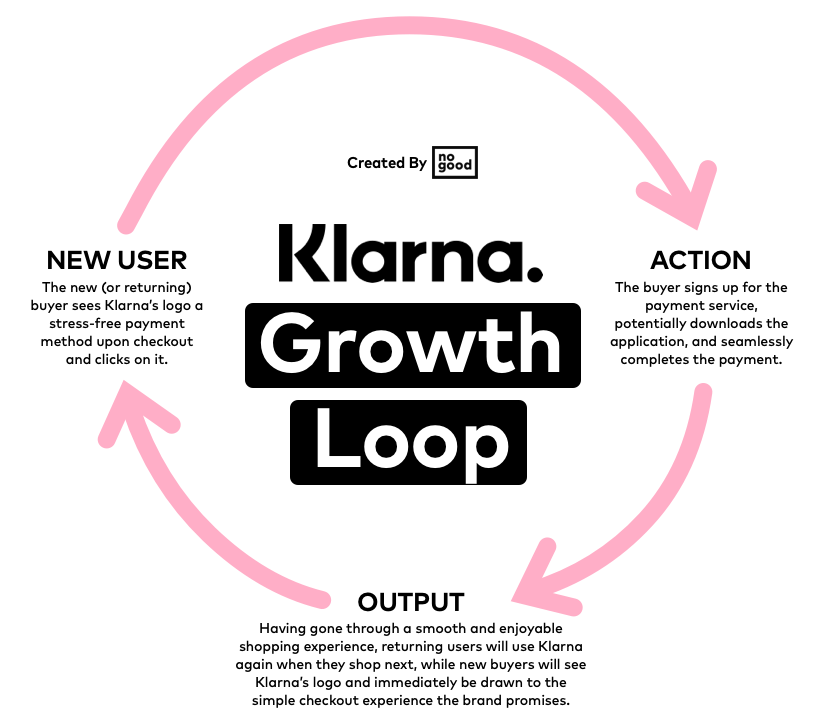
- Klarna places its logo on partner brands’ websites and at the checkout points, promoting their easy, pay-in-four-installments checkout option and reminding the buyer of all the creative marketing activations that established an emotional connection.
- The new (or returning) buyer sees Klarna’s logo as a stress-free payment method upon checkout and clicks on it.
- The buyer signs up for the payment service, potentially downloads the application, and seamlessly completes the payment.
- The buyer receives customized email updates and push notifications that inspire to shop for new items — all based on the shopper’s unique purchasing behavior. Having gone through a smooth and enjoyable shopping experience, returning users will click on Klarna’s method again when they shop next, while new buyers will see Klarna’s logo and immediately be drawn to the simple checkout experience the brand promises.
In this loop, everything works together to remind the customer about the “smooothness” of shopping with Klarna. With the careful placement of Klarna’s pink and recognizable logo, the brand draws in new customers with the buy-now-pay-later promise and leers loyal customers back through the pleasant and inspirational experience that all of Klarna’s touchpoints (from checkout to in-app browsing) offer. At the same time, all of Klarna’s creative marketing efforts contribute to helping the customers remember and associate enjoyment, seamlessness, and inspiration with the shopping service.
In other words, Klarna’s growth strategy isn’t solely based on brand or performance; the brand doesn’t concentrate its efforts and investment into creativity or analytics one at a time. Instead, the unicorn’s success lies in bridging the gap between brand design and performance marketing, creating a holistic performance branding strategy that results in rapid and overarching growth — a more successful approach than the traditional focus on one marketing direction or the other.
Looking to build trust, loyalty, and long-term growth for your FinTech company?
Takeaway
Klarna’s epic entrance into the payment industry has changed the game rules, to say the least. While the competitors have been following the same common patterns of speaking to the Riders of their customers, appealing to their sense of reason, focusing on the transactional aspect of shopping, Klarna moved in the complete opposite direction; they put the customer at the center of its brand strategy and develop an emotional bond with the shoppers all while connecting with their inner Elephants.
Klarna’s creativity-driven approach to growth and scaling allowed the brand to provide a full, end-to-end shopping experience that inspires shoppers to find what they love and complete the purchase seamlessly. What Klarna has mastered is consistency — its promise of a “smoooth” experience extends beyond the purchase process and into all interaction points with customers, from pop-up experiences to marketing campaigns and in-app experiences. The brand exudes the concept of “smoooth” through and through.
What Klarna did was create a whole new approach to marketing in the fintech industry.Klarna has built brand equity around seamless customer experiences and customer loyalty, and leverage the powerful brand image it has built to activate a growth loop that continuously adds new users to its funnel while keeping the returning customers engaged and loyal.
Relentless customer-centricity and creativity in Klarna’s approach to internal and external processes have helped the brand become a one-of-its-kind disruptor in an otherwise stern industry. Klarna has carved out its own niche in the market, making other industry players rethink their relationships with customers and the value of emotional bonds that last a long time.
Find out how we can drive growth for your FinTech company






